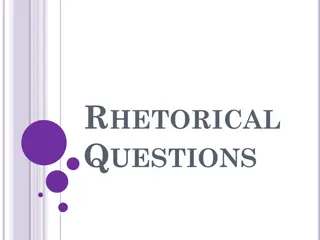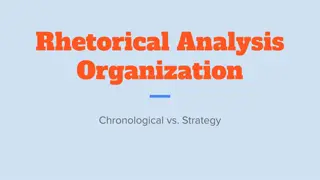Analyzing Rhetorical Devices in "The Santa Ana Winds" by Joan Didion
Exploring the use of rhetorical devices in Joan Didion's essay "The Santa Ana Winds," focusing on the mood created through diction and imagery. Through careful analysis, the essay demonstrates how Didion strategically develops an ominous atmosphere that evokes a sense of unease and impending danger for the reader.
Download Presentation

Please find below an Image/Link to download the presentation.
The content on the website is provided AS IS for your information and personal use only. It may not be sold, licensed, or shared on other websites without obtaining consent from the author.If you encounter any issues during the download, it is possible that the publisher has removed the file from their server.
You are allowed to download the files provided on this website for personal or commercial use, subject to the condition that they are used lawfully. All files are the property of their respective owners.
The content on the website is provided AS IS for your information and personal use only. It may not be sold, licensed, or shared on other websites without obtaining consent from the author.
E N D
Presentation Transcript
How to Write Rhetorical Device Entries
Step 1 Select a device from your reading that stood out to you ie: mood Write the term and its rhetorical definition next to it Mood: The prevailing atmosphere of emotional aura of a work. Setting, tone, and events can affect the mood. Mood is similar to tone and atmosphere.
Step 2 Write the example from your reading EXACTLY as it appears in the text. If you are using a term that encompasses the whole piece, describe how it appears in the text. Mood: Joan Didion s narrative essay The Santa Ana Winds evokes an ominously eerie feeling throughout.
Step 3 Put the citation directly beneath the example. Make sure it is MLA format. Mood: Joan Didion s narrative essay The Santa Ana Winds evokes an ominously eerie feeling throughout. Citation: Didion, Joan. The Santa Ana Winds. Slouching Towards Bethlehem. New York: Farrar, Straus and Giroux, LLC., 1996. Print.
Step 4 Begin your function discussion. Start with context briefly establish the nature/character of the speaker of the text, the intended audience, and the purpose the speaker wants to achieve with that audience on that subject. Also capture how audience and speaker feel toward each other and the subject. Function: In her essay, The Santa Ana Winds, Joan Didion develops an ominous mood for her readers to recreate the uncertainty that precedes the natural phenomena of the wind, proving its affect on human behavior.
Step 4 Move into the strategy/effect Based on the context, you should establish what strategy the speaker employs to try to achieve the purpose. Function: In her essay, The Santa Ana Winds, Joan Didion develops an ominous mood for her readers to recreate the uncertainty that precedes the natural phenomena of the wind, proving its affect on human behavior. She artfully unfolds the eerie feeling through her diction to place her audience in what feels like an uncontrollable nervousness.
Step 4 Device Once you ve clearly articulated the strategy, accurately identify your chosen rhetorical device and make a claim about how it produces that rhetorical effect Function: She artfully unfolds the eerie feeling through her diction to place her audience in what feels like an uncontrollable nervousness. From the beginning sentences, Didion sets the mood by revealing an uneasy feeling in the air and that a wind will whine through the city. Further on, she recounts stories she has heard using words such as ominously, eerie, and screaming to create what one might expect in the exposition of a horror movie. These choices subtly build to a growing terror for her audience, which emulates that same disturbance Didion feels as the winds approach. Through her carefully chosen word choice, the reader is chilled, perhaps even looking over the shoulder to make sure no one is standing behind him/her. However, Didion rather abruptly switches her mood to a more technical feeling later on. Her choice of scientific diction through words like foen wind ions and solar make her reader feel almost safe; this stark juxtaposition brings about an uneasy suspense so that she leaves a hint of the unsettling feeling.
Step 5 Connection Discuss in clear and specific terms how your device achieves the rhetorical effect you claim it does. Then connect this to the speaker s purpose. Function: From the beginning sentences, Didion sets the mood by revealing an uneasy feeling in the air and that a wind will whine through the city. Further on, she recounts stories she has heard using words such as ominously, eerie, and screaming to create what one might expect in the exposition of a horror movie. These choices subtly build to a growing terror for her audience, which emulates that same disturbance Didion feels as the winds approach. Through her carefully chosen word choice, the reader is chilled, perhaps even looking over the shoulder to make sure no one is standing behind him/her. However, Didion rather abruptly switches her mood to a more technical feeling later on. Her choice of scientific diction through words like foen wind ions and solar make her reader feel almost safe; this stark juxtaposition brings about an uneasy suspense so that she leaves a hint of the unsettling feeling. By the end, when she uses friction to again subtly remind her audience that a presence out of our control looms to regulate our behavior, she has purposefully convinced her audience through her words and mood that some natural elements are out of our control. Thus, she leaves her audience with a mood of foreboding. In so doing, Didion has brought her readers to question weather winds (or other natural forces like the moon) really do influence our behaviors. Her audience is thus convinced there is often an inexplicable force which takes control.























